Honeywell HPA100 Review
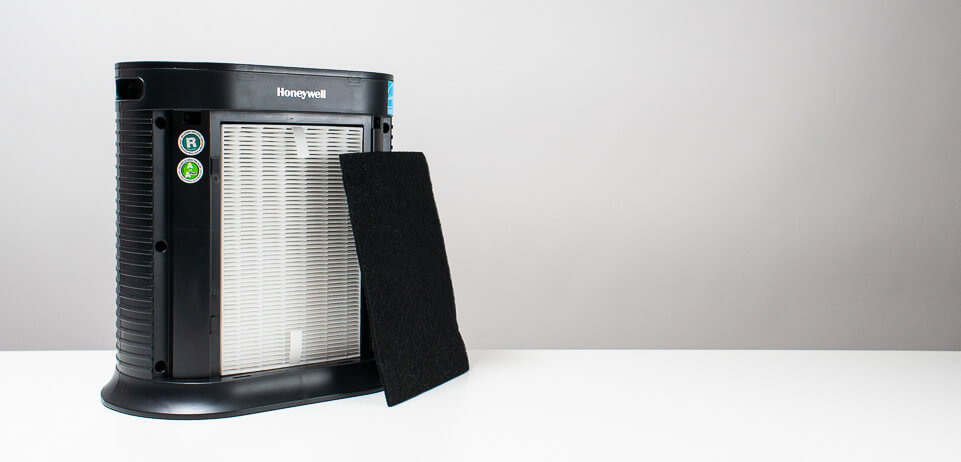
Feature Scores
Pros
- Unit is equipped with a HEPA filter – not a lesser filter like a HEPA Type or proprietary particle filter as is common for units in this price range
- Great portability - unit is very light and has handles on both sides
- All control panel lights can be turned off for operating the unit in a dark room
- Black plastic exterior is great for keeping the unit looking clean
- 5 year warranty - most other air purifiers have a 1 to 3 year warranty
Cons
- Poor energy efficiency – high power draw considering the unit’s relatively low CFM
- Poor performance in our noise output tests – unit isn’t very quiet
Editor's Score
Quick Facts
| Particle filter type | HEPA |
|---|---|
| Gas filter type | Carbon |
| Pre-Filter | No dedicated filter - carbon filter doubles as pre-filter |
| Output | Approx. 110 CFM (up to 150 sq. ft. area of coverage) |
| Air Movement | Front grille > carbon filter > HEPA filter > up and out of top of unit |
| Number of fan speeds | 4 – low, medium, high, and turbo |
| Size | 14 in. tall x 14 in. wide x 9 in. deep |
| Weight | 7.5 lb. |
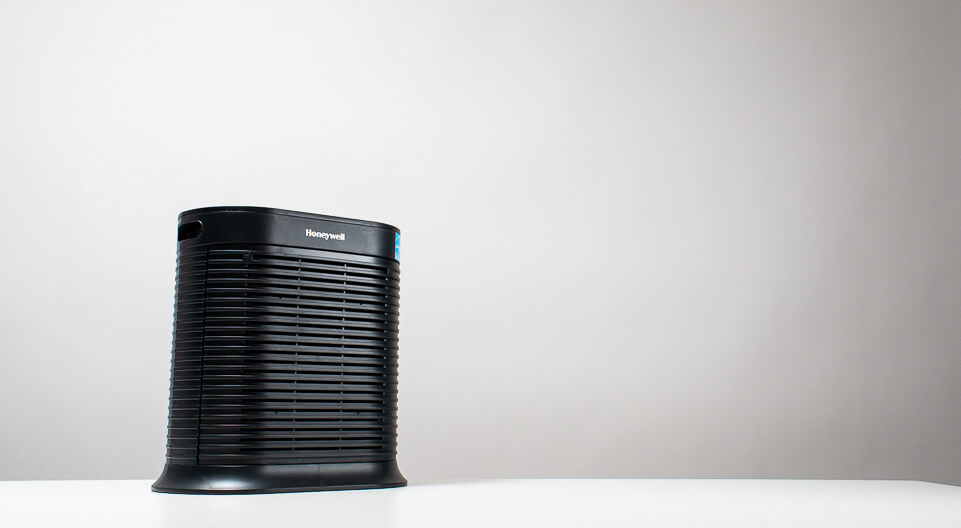
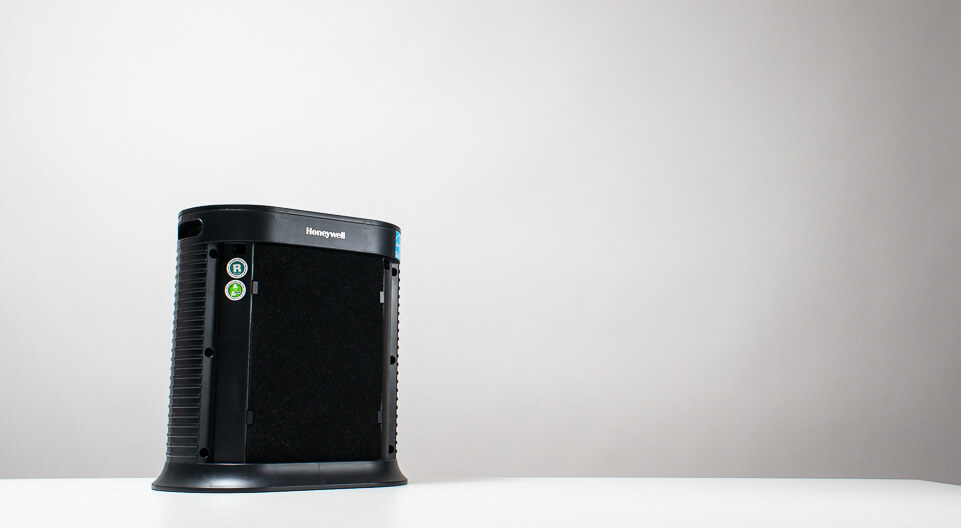
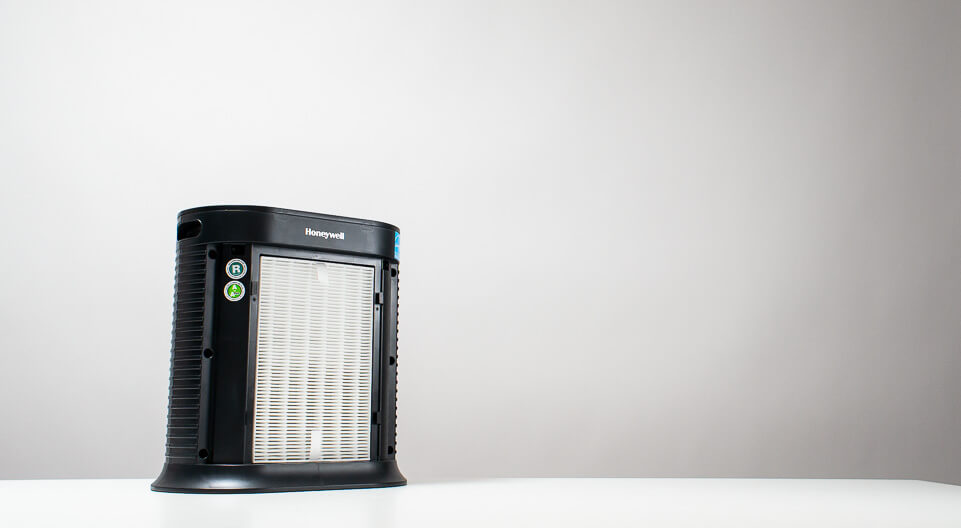
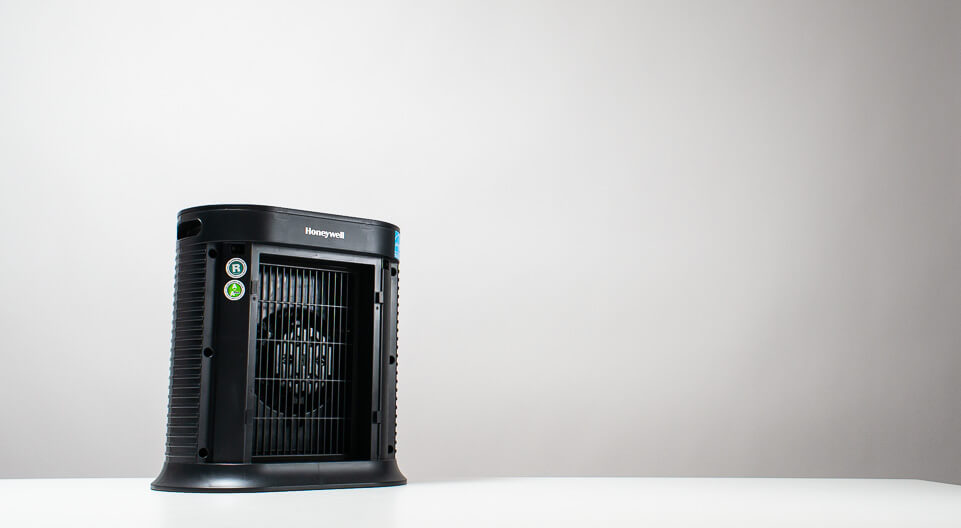
Analysis
A step by step breakdown of the HPA100's performance.
Air Processing Performance
Test Results
In an approx. 150 sq. ft. test environment, the HPA100 took approx. 22 minutes to lower room particle concentration from 10,000 particles per cubic foot (particles 0.5 micron and larger) down to 1,000 particles per cubic foot. We consider this latter concentration – 1,000 particles per cubic foot – to be the maximum acceptable particle concentration for “clean air” in a residential environment.
Units with approx. the same output (CFM) like the GermGuardian AC4825 and Blue Pure 411 took 23 minutes and 18 minutes, respectively, to achieve the same low concentration – 1,000 particles per cubic foot. Higher output units like the Coway Mighty (250 CFM), for example, took about 10 minutes.
Thus, the HPA100 cleans air just as fast as comparable units with approx. the same CFM and about half as slowly as units with approx. double its CFM, as expected.
The lowest particle concentration the HPA100 was able to achieve during our testing was 900 particles per cubic foot. It took an additional 27 minutes to achieve this concentration from the time it achieved 1,000 particles per cubic foot – for a total of 22 + 27 = 49 minutes to achieve 900 particles per cubic foot.
Here are the results for the three other models mentioned above:
| Model | Lowest concentration achieved (particles per cubic foot) |
|---|---|
| GermGuardian AC4825 | 500 |
| Blue Pure 411 | 600 |
| Coway Mighty | 100 |
Thus, the HPA100 cannot achieve quite the same low level of particle concentration as comparable units (with similar CFM) and especially units with greater CFM. However, what it is able to achieve – 900 particles per cubic feet – is still a very low particle concentration that will satisfy the vast majority of consumers.
Filter Analysis
Particle Filter
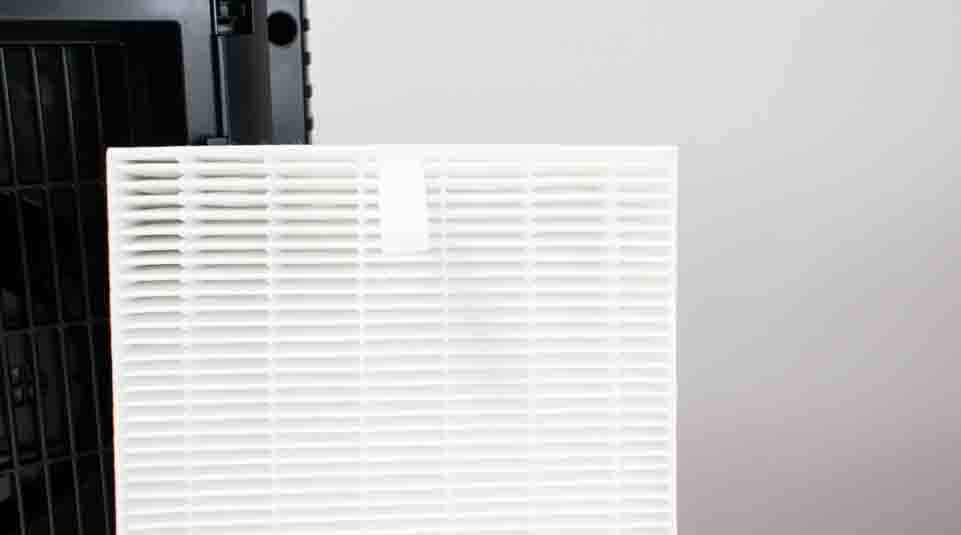
The HPA100 features a true HEPA filter for particle filtration (allergens, mold, dust) and a carbon filter for gas filtration (VOCs, odors). This unit does not come equipped with a separate dedicated pre-filter for removing large particles. Instead, the carbon filter doubles as a pre-filter to remove larger particles before they get to the HEPA filter.
The fact that the HPA100 is equipped with a true HEPA filter is definitely a strong positive for it, especially considering its price point – around $100. At this low price there are quite a few units on the market that come with a HEPA Type filter instead of a HEPA filter. HEPA Type filters do not filter nearly as well as true HEPA filters. With its true HEPA filter, the HPA100 is equipped to filter particles very well. HEPA filters remove 99.97% of particles 0.3 microns and larger that travel through them.
Gas Filter
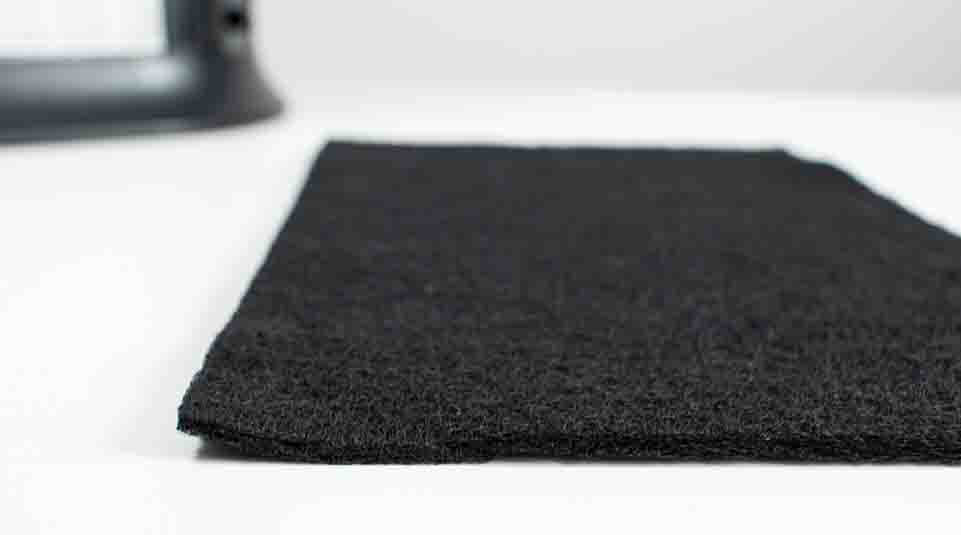
Like most other air purifiers at this price point, the HPA100 comes equipped with a carbon filter that is comprised of a fibrous material instead of carbon pellets. This makes for less surface area for unwanted gas (VOCs, odors) adsorption and therefore less effective gas filtration than a filter that consists of carbon pellets. Gas filtration – removing odors, etc. – is not a strong point for this air purifier. If gas filtration is important to you, a unit equipped with a carbon filter with carbon pellets is a must. The Winix 5500-2 is our recommendation here.
Pre-filter
The lack of a separate dedicated pre-filter also hurts the Honeywell’s score in the category. Units like the Coway Mighty and Winix 5500-2 come with a separate washable pre-filter. Large particles build up on the washable filter and eventually it has to be vacuumed and/or rinsed to remove those particles.
The HPA100’s carbon “pre-filter” has to be replaced when it saturates with large particles. And it has to be replaced at a cost. Do note that this setup (where the carbon filter doubles as a pre-filter) is common at this price point. The aforementioned Coway Mighty and Winix 5500-2 retail in the approx. $150 to $200 range.
Ionizer
The HPA100 does not come equipped with any type of ionizer.
Air Movement
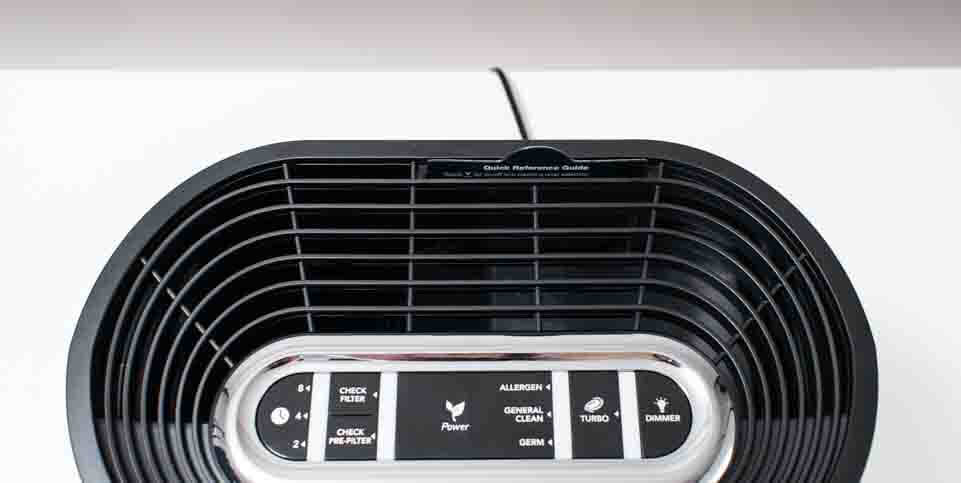
The HPA100 processes approx. 110 cubic feet of air every minute (110 CFM). This level of air flow through the unit’s HEPA filter (99.97% efficiency) makes it viable in rooms up to 150 sq. ft. (assuming a ceiling height no higher than 10 ft.). In a room any larger than 150 sq. ft. the HPA100 will not be able to process air fast enough to properly maintain an acceptable level of particle concentration.
Do note that the HPA100 has to be set to maximum fan speed to service a 100 to 150 sq. ft. room. At this maximum fan speed the unit is very loud and isn’t very energy efficient.
Look for an air purifier with greater total output (higher CFM) like the Coway Mighty or Winix 5500-2 if you’d like to run it in a small 150 sq. ft. room at lower fan speeds where it will be less noisy and offer better energy efficiency than the HPA100. Such a unit will also be able to service a much larger room (up to 300 sq. ft.) on its maximum settings.
Energy Efficiency
The Honeywell HPA100 has poor energy efficiency compared to most other air purifiers on the market.
The HPA100 draws about 50 watts of power at an output of approx. 100 CFM on maximum fan speed. For comparison, the GermGuardian AC4825 draws about 44 watts and the Blue Pure 411 draws only about 10 watts at the same output (at approx. 100 CFM). The Coway Mighty draws slightly more – about 70 watts of power – but at more than double the output (approx. 250 CFM).
That all being said, do note that 50 watts is not a lot of power draw compared to many other appliances. For example, the average clothes dryer draws about 4000 watts of power while the average dishwasher draws about 1500 watts of power. Even if you use the air purifier 24/7 it won’t cost you more than about $50 per year in energy costs in most states.
Noise Output
The Honeywell HPA100 is also not a very quiet air purifier.
It certainly can get fairly quiet on low fan speeds – 51.5 dB on its lowest setting. However, this minimum noise level is still higher than it is for the comparable units. On the same setting the GermGuardian AC4825 was measured at 44.2 dB and the Blue Pure 411 was measured at approx. 40 dB.
Furthermore, all of this noise output data for the HPA100, AC4825 and 411 is essentially meaningless as these units cannot be used on these minimum fan speeds and still be effective in even very small rooms (as small as 100 sq. ft.). They have to be run on maximum fan speed to be effective even in such a small room.
On maximum fan speed here are their noise output results:
| Model | dB |
|---|---|
| HPA100 | 68.7 |
| AC4825 | 61.2 |
| 411 | 65.4 |
Again, the Honeywell is the worst performer of the group. What makes matters worse is when you compare these noise levels to the noise level of a larger unit like the Coway Mighty at the same output (approx. 100 CFM). Remember, the Coway can be set to a lower fan speed to achieve the same output of these smaller units at their highest fan speed.
The Coway’s noise output at approx. 100 CFM is only 48.9 dB.
Thus, the HPA100 is not only louder than comparable units (similar CFM) on low and high fan speed, but it is also much much louder than higher CFM units (like the Coway) at the same output – 68.7 dB for the Honeywell compared to 48.9 dB for the Coway.
Durability
The HPA100 doesn’t have the best build quality but it does come with a 5 year warranty. Most other air purifiers on the market are better built but come with shorter warranties. For example, the GermGuardian AC4825 comes with only a 3 year warranty. The Blue Pure 411 does come with a 5 year warranty as well.
Ease of Use
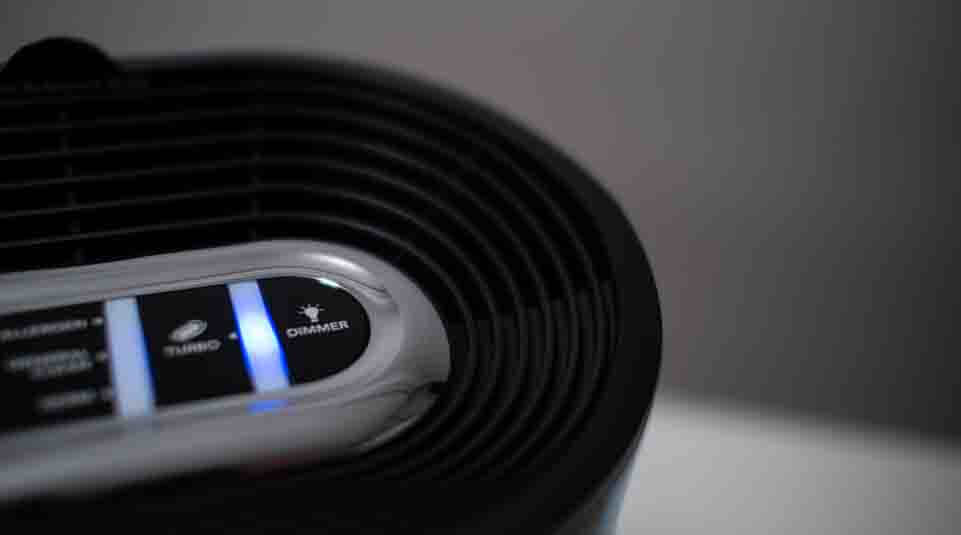
The HPA100’s control panel lights can all be turned off. This is especially helpful if you want to run the unit at night in a dark room and you’re sensitive to any lights being on in the room.
The unit is very small, light, and can easily be picked up with two side pocket handles making it highly portable.
The unit does come equipped with a timer that can be set to 2, 4, or 8 hours.
It does not come with a remote or any type of smart functionality (wireless control via an app).
Value
The HPA100 is overall a poor value.
It retails for around $100 – fair enough. The AC4825 is about $20 less expensive while the 411 is either similarly priced or sometimes it can be as much as $20 more expensive. These low CFM units are all very similarly priced – at least initially.
Where the HPA100 loses points in this category is
- Long term energy cost and
- Filter costs
Recall that the energy costs for this unit won’t be very much, but they’re still substantially more than they are for certain other units. For example, the 411, has one fifth the energy costs of the HPA100.
Filter costs for this unit aren’t very high compared to units in the same price range but they end up being much more than they are for many other units on the market.
Here’s how:
The HPA100 and AC4825 have a filter set (consisting of a particle and gas filter) that costs about $20 to $30 to replace. Not too bad. But here’s where things get problematic: Both units have carbon filters that double as pre-filters. These filters saturate very quickly with large particles. Thus, they have to be replaced often – much more often than units equipped with a washable pre-filter.
The bottom line here is that both of these units require much more frequent filter replacement than larger units with separate washable pre-filters. More frequent filter replacement is more money out of your pocket over time and a lower value proposition for both of the HPA100 and the AC4825.
Verdict
Our bottom line recommendations.
If your budget is limited we would recommend the AC4825 over the HPA100. It’s slightly cheaper, more energy efficient, and quieter.
If you can spare spending a little bit more we would recommend a larger full size air purifier like the Coway Mighty. It’s slightly more expensive but much more energy efficient, much quieter, and it also has a separate washable pre-filter to extend the life of its primary filters.
Add a Comment
Have a question or comment? Let us know below.
Comments (1)
When is the filter of honeyell hpa 100 is replaced?
It depends on how often and under what conditions you use the air purifier, but the general recommendation is once every 12 months for the HEPA filter and once every 3 months for the carbon pre-filter.